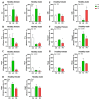Maternal Intake of Either Fructose or the Artificial Sweetener Acesulfame-K Results in Differential and Sex-Specific Alterations in Markers of Skin Inflammation and Wound Healing Responsiveness in Mouse Offspring: A Pilot Study
- PMID: 37299497
- PMCID: PMC10255090
- DOI: 10.3390/nu15112534
Maternal Intake of Either Fructose or the Artificial Sweetener Acesulfame-K Results in Differential and Sex-Specific Alterations in Markers of Skin Inflammation and Wound Healing Responsiveness in Mouse Offspring: A Pilot Study
Abstract
Growing evidence has demonstrated that maternal artificial sweetener (AS) consumption may not be a beneficial alternative when compared to sugar-sweetened beverages and potentially leads to metabolic dysfunction in adult offspring. Compromised skin integrity and wound healing associated with type 2 diabetes can lead to complications such as diabetic pressure injury (PI). In this context, the skin plays an important role in the maintenance of metabolic homeostasis, yet there is limited information on the influence of sugar- or AS-sweetened beverages during pregnancy on developmental programming and offspring skin homeostasis. This study examined the impact of maternal fructose or acesulfame-k consumption on offspring wound healing. Female C57Bl/6 mice received a chow diet ad libitum with either water (CD), fructose (FR; 34.7 mM fructose), or AS (AS; 12.5 mM Acesulfame-K) throughout pregnancy and lactation. PIs were induced in offspring at 9 weeks of age (n = 6/sex/diet). PIs and healthy skin biopsies were collected for later analysis. Maternal AS intake increased skin inflammatory markers in healthy biopsies while an FR diet increased Tgfb expression, and both diets induced subtle changes in inflammatory markers post-wound inducement in a sex-specific manner. Furthermore, a maternal FR diet had a significant effect on pressure wound severity and early wound healing delay, while AS maternal diet had a sex-specific effect on the course of the healing process. This study demonstrates the need for a better understanding of developmental programming as a mediator of later-life skin integrity and wound responsiveness.
Keywords: DOHaD; adipose tissue; animal model; artificial sweetener; developmental programming; fructose; inflammation; maternal nutrition; pressure injury; skin; wound healing.
Conflict of interest statement
The authors declare no conflict of interest.
Figures







Similar articles
-
Maternal intake of fructose or artificial sweetener during pregnancy and lactation has persistent effects on metabolic and reproductive health of dams post-weaning.J Dev Orig Health Dis. 2022 Oct;13(5):642-649. doi: 10.1017/S2040174422000022. Epub 2022 Mar 24. J Dev Orig Health Dis. 2022. PMID: 35322784
-
Impact of Maternal Intake of Artificial Sweetener, Acesulfame-K, on Metabolic and Reproductive Health Outcomes in Male and Female Mouse Offspring.Front Nutr. 2021 Dec 6;8:745203. doi: 10.3389/fnut.2021.745203. eCollection 2021. Front Nutr. 2021. PMID: 34938757 Free PMC article.
-
Consumption of the Artificial Sweetener Acesulfame Potassium throughout Pregnancy Induces Glucose Intolerance and Adipose Tissue Dysfunction in Mice.J Nutr. 2020 Jul 1;150(7):1773-1781. doi: 10.1093/jn/nxaa106. J Nutr. 2020. PMID: 32321168
-
Maternal Fructose Diet-Induced Developmental Programming.Nutrients. 2021 Sep 20;13(9):3278. doi: 10.3390/nu13093278. Nutrients. 2021. PMID: 34579155 Free PMC article. Review.
-
Early Life Fructose Exposure and Its Implications for Long-Term Cardiometabolic Health in Offspring.Nutrients. 2016 Nov 1;8(11):685. doi: 10.3390/nu8110685. Nutrients. 2016. PMID: 27809266 Free PMC article. Review.
References
-
- Imamura F., O’Connor L., Ye Z., Mursu J., Hayashino Y., Bhupathiraju S.N., Forouhi N.G. Consumption of sugar sweetened beverages, artificially sweetened beverages, and fruit juice and incidence of type 2 diabetes: Systematic review, meta-analysis, and estimation of population attributable fraction. Br. J. Sports Med. 2016;50:496–504. doi: 10.1136/bjsports-2016-h3576rep. - DOI - PMC - PubMed
-
- Clayton Z.E., Vickers M.H., Bernal A., Yap C., Sloboda D.M. Early Life Exposure to Fructose Alters Maternal, Fetal and Neonatal Hepatic Gene Expression and Leads to Sex-Dependent Changes in Lipid Metabolism in Rat Offspring. PLoS ONE. 2015;10:e0141962. doi: 10.1371/journal.pone.0141962. - DOI - PMC - PubMed
MeSH terms
Substances
Grants and funding
LinkOut - more resources
Full Text Sources
Medical
Research Materials
Miscellaneous

